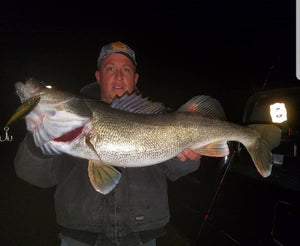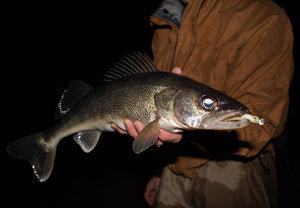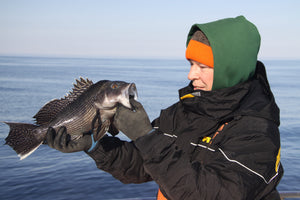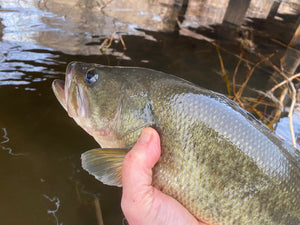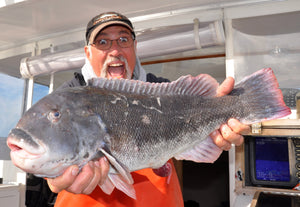Basic Fall Blackfish

While most anglers set their sights on striped bass and slammer blues during the fall season, there is a cadre of fishermen who actually prefer the inshore bottom-fishing game. Among this group, primarily comprised of hard-core fishing veterans, blackfish are considered the prime late-season target. That’s because although they are sometimes hard to find and tough to hook they sure know how to battle and are tasty on the plate. In short, they provide both a significant challenge and a great meal while still offering a better than reasonable shot at success on any given trip.
Although it may sound intimidating, blackfishing can be a blast once you get the hang of it. Just figure that, in the beginning, you’ll have to earn every fish. Catch a few, however, and you’ll quickly realize it isn’t hard to become a blackfish fan. You’ll know you’re hooked when you pass on breaking bass and bluefish – perhaps even albies – in route to some rough and tumble bottom. While many seasoned blackfish fans enjoy jigging their ‘tog in shallow water at the start of the season, beginners often have more success fishing crab baits on bottom rigs, especially late in the season as the fish concentrate around deep-water wrecks, mussel beds and boulder fields. Since that deep-water migration is already underway, we’ll cover bait-fishing today and save the jigging discussion for next spring.

Blackfish are a prime fall target but be sure to dress appropriately for the weather conditions. This bulldog was caught by Ethan Gross aboard the Orient Point charter boat, Nancy Ann IV. OutdoorTom.com photo.
WATER TEMPS AND STRUCTURE ARE KEYS
The keys to finding blackfish lie in water temperature and structure. Most anglers are aware that blackfish love to hang around underwater obstructions and rocky bottom, but they frequently fail to consider that “tautog” as New Englanders call this member of the wrasse family, also prefer water temperatures ranging between 50 and 60 degrees, give or take a degree or two on each end of the spectrum. To stay in this range the fish move inshore and off throughout the season, coming to the shallows in spring and fall and holding deeper during summer and winter. In most areas, the inshore fall run peaks between mid-October and mid-November.
From a structure standpoint, ‘tog prefer snag-infested “live” bottom that hosts an abundance of crabs and mussels. When the tide is slack, the blacks hide within crevices, holes, depressions and cut-outs. As the tide begins to push, they take up feeding positions at the head and along the lead outside edges of any specific piece, scoffing up tasty morsels like green, calico or Jonah (white) crabs that get caught in the current and tumble past. At the height of the tide, the chunky-shaped blacks tuck inside or behind structure to get out of the current, returning to their feeding stations as the tide relents later in the day - thus their reputation for feeding most aggressively at the start and end of a tide, when currents are generally mild to moderate.
Since blackfish rarely wander more than a few yards from structure during their feeding forays, it is vital to anchor-up so that your baits will touch down within a few feet of a boulder, wreck, mussel hump, bridge abutment or whatever structure is holding the fish. For this reason, experienced blackfishermen usually double-anchor their boats from the bow and ease back until almost directly over a selected piece of bottom. As a rule, the biggest blacks prefer the nastiest, snag-infested real estate, so if you aren’t losing some tackle, you aren’t fishing in the right place. (Note that a significant number of anglers now opt to use location locking abilities on their trolling motors to keep their vessel in position without dropping anchor. It’s a real advantage if you have the means as it allows for easy and precise position adjustments and keeps you over favored bottom as well as an anchor in many cases.)
When it comes to tackle for basic blackfishing, a 6- to 7-foot, medium action rod and sturdy conventional reel should get the job done in most situations. We’re not suggesting anything too fancy for this application, just a solid rod and reel combo such as a ?????????? rod matched to a ????? reel. Depending on how deep you fish and current strength, you can target these battlers with lines as light as 12-pound-test or as heavy as 60-pound-test. The rule is to use the lightest sinker that will let you hold bottom. Of course, the later into the season you go, the deeper the water that holds the action. That means you’ll need to use heavier line to accommodate larger weights, often 6- to 12 ounces as you get out into water depths of 80 feet or more. As a general rule, 30- to 40-pound-test braid gets the job done under most conditions.
As for the terminal end, simplicity is key when it comes to bait-fishing for blackfish. The more hardware added, the greater the chances of tangling the line or snagging bottom. While many anglers opt for high-low rig and dual-hook snafu rigs, a single-hook set-up allows you to really concentrate on one bite at a time while reducing the odds of getting caught on the bottom. Use a clinch knot to tie a 30-inch leader of 30 - 40-pound-test mono or fluorocarbon leader material to a black barrel swivel at the end of the main line, then add an end loop to the opposite end to hold a bank sinker. Next, tie in a size four, Octopus or Virginia-style blackfish hook via a dropper loop six to eight inches above the sinker. It’s also a good idea to add a simple over-hand knot two inches above the sinker so that you can break off without losing your hook - or a trophy black lodged in bottom – should your sinker get snagged.

The end result – tasty fillets for the entire crew. OutdoorTom.com photo.
A MATTER OF TIMING
Finding blackfish and getting bait to fall right in front of them is only half the battle, setting the hook and hauling ‘em up is the other. The hook-setting seems to be especially frustrating to novice anglers and with good reason. This species, you see, sport two sets of teeth: a pair of buck teeth just behind the lips used for picking meals from their perch, and a molar-like set used to crack and grind the shells of crabs and mussels.
When a blackfish picks up a bait, the item is held by the front teeth for a moment, then sent back to be pulverized by the second set. Try to set the hook on the first tap and you’ll pull the bait away. Not until the bait is passed back can the point be firmly set. Wait too long, however, and the hook is expelled with the crushed crab shell.
It’s a timing thing, hooking blackfish, something that requires practice to acquire the knack. Keeping a finger to your line to feel the difference between the pick-up and the swallow will help you learn when to make your move. When you do set the hook, drive it hard so the point penetrates the tough skin that surrounds your quarry’s mouth. Lift your rod high with your arms fully extended toward the sky as you feel the point stick. This will haul the fish up and away from the bottom so that when it turns to dive it should come up a few feet short of the nearest hang-up. Only once the fish is clearly headed toward the surface should you lower your arms to a more normal fighting position. A tight drag also helps prevent these brawlers from returning to their lairs - but don’t go too tight or a bulldog might snap the line at a knot.
AIN'T EASY BEING GREEN
Although blackfish will scoff up clam and worm baits, green, Asian and white crabs are better choices as they limit the number of attacks from porgies and small sea bass. Some anglers use fiddlers or hermit crabs, but the greens and whites stay on the hook better to interest slower, more cautious lunkers. Green crabs work throughout the season while whites are preferred for fishing in deeper water well into the fall.

Using green crabs requires a bit of work. Those with shells smaller than a silver dollar can be offered whole. To rig these, break off the legs on one side and insert the hook point though one leg socket and out another so it is fully exposed. Leave the legs on the opposite side.
Larger green crabs can be fished whole if you are looking to drill a pool winner. Otherwise, they work best when split in half or even quartered. Remove the top shell and split the crab from front to back. If it's a really large crab, divide each section in half again. Now, remove the legs and claws and insert the hook though one exposed leg socked and up through the back shell at the hinge so the hook point protrudes fully. This last thought - ensuring the point of the hook fully stands free from the crab - is absolutely vital because it is nearly impossible to drive a buried hook though the crab and into your quarry. Be sure to check every bait before sending it to the bottom and you’ll be well on your way to gathering some tasty blackfish fillets.
- Bryce Poyer

